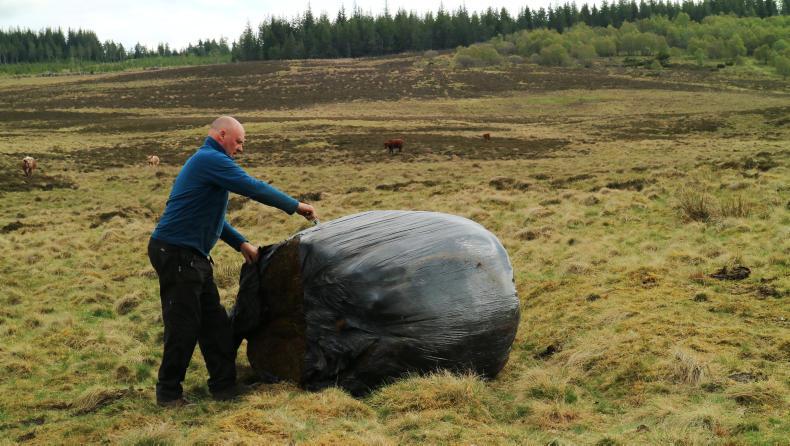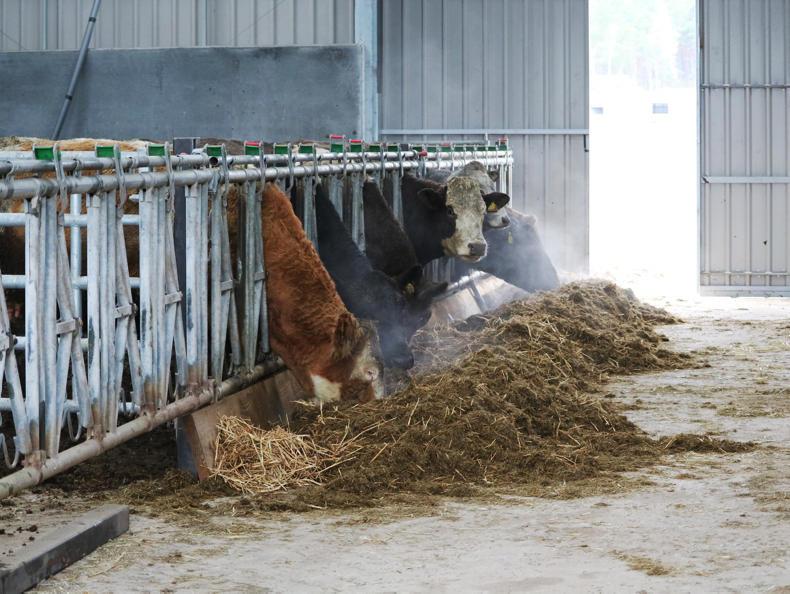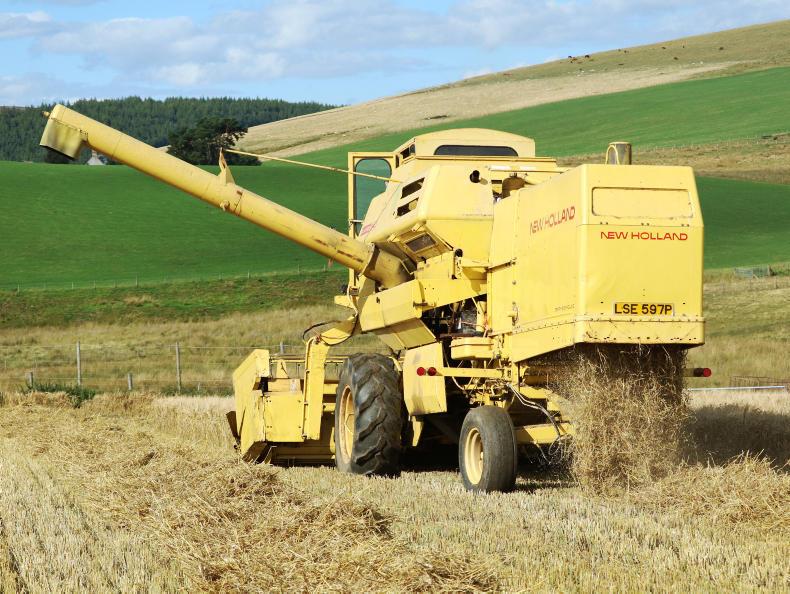T he Duffus family farms at Auchriachan farm near Tomintoul in the Cairngorms. Auchriachan is a hill farm of 1,540ha, comprised of mainly region 3 land, running up to 600m.
Auchriachan accounts for 56% of the total farmed area of the farms in the Farm Profit Programme and is nearly 12 times as large as the smallest unit.
However, despite it having such a significant proportion of the farmed area, at the start of the project it only accounted for 14% of the total cattle and 49% of the sheep in the project. While this does demonstrate the difference in the carrying capacity of the land, there is still significant potential on the farm.

Andy feeding his hill herd of Highland and Shorthorn cows.
It was quickly identified that one of the key factors restricting the farm was a lack of output. Overheads, while relatively modest in comparison with the other units in the project, swallowed 71% of the gross output of the farm.
One avenue to solve this would have been to slash the overheads. However, as already mentioned, they were relatively modest in relation to the other farms in the project. Instead, the plan on the unit has been to increase the output, thus diluting the overheads, allowing the business to move to a sustainable profit.
However, one constraint to expansion was a lack of shed space, so increasing the existing cattle enterprises was not feasible unless the Duffuses were to build another shed, increasing the overheads.

Winter accomodation was a limiting factor in herd expansion which prompted the start of their hill herd.
The Duffus family chose to establish a herd of hill cattle. This solved several problems all at once. Firstly, they bring increased output with very little increase in fixed costs. Secondly, they will eat the less palatable grass on the hill, allowing better-quality grass to flourish for the sheep. Thirdly, not only are they a low financial input enterprise, they are also a low labour input enterprise.
As the calves had not been sold at the time of the benchmarking, they were valued out of the enterprise at the close of the period at a weight of 154kg and value of £309. Indeed, they are still on the farm and most likely will not be sold until the autumn at around 400kg, meaning the actual output from the enterprise will be nearer £800.
Due to the fact that the cattle are wintered on the hill, feed and bedding costs come to £11. These contribute to the enterprise having a gross margin per head of £183/cow in 2019.
The in-bye herds have not fared as well. Both of these herds are carrying increased forage costs for the benchmark year. This is primarily down to increased fertiliser use. The business had taken on extra ground three years before the project began. Unfortunately, soil indices were very low on the unit and there has been significant extra fertiliser and lime spend improving these.
However, this is nearing completion and the 2020 fertiliser bill will be over £3,000 less than the 2019 bill.

The farm produces spring barley for feeding livestock stock.
Overfed bull takes his toll
The spring calvers’ performance was hampered by poor conception rates. The bulling period for the 2019 figures occurred in the dry summer of 2018 when a new bull performed badly, leaving many cows empty. The bull went on to die due to abscesses on the liver that were put down to overfeeding as a youngster. Unfortunately a further four calves died at birth, and this led to an overall weaning rate from the group of 55%.
Calf sale weights are averaging 22kg more than the benchmark year, meaning calf values have risen by £40. However, with the low weaning rate, output per cow to the bull has fallen by £332.
Offsetting some of this loss is a significant reduction in variable costs per cow. Between keeping the cows outdoors longer and the reduced number of calves to feed, concentrates use has fallen by 500kg/cow. Adding this to the rest of the feed reductions, feed and bedding costs have fallen by £75/cow.
This all adds up to a gross margin per cow of £106.
Were the weaning rate to be nearer the long-term average, with all else equal, the output per cow would be £358/cow more, demonstrating the havoc an under performing bull can wreak in a herd.
Autumn herd output up £49/cow
The autumn herd demonstrates an improved level of output of £49/cow. This is being driven by an increase in the weaning rate from 85% to 90% and an increase in calf sale weight of 22kg. However, the calf sale price is back by 19p/kg on the benchmark year, meaning that like-for-like calf values are short by £79.
The weather conditions of 2018-2019 also saw an increase in the amount of concentrates used per cow rise to 68kg. This is in a year when the cost of concentrate rose 12%, pushing the cost per cow in the herd to £22/cow. Coupling this with the rest of the increased costs for the 2018-2019 winter, the herd saw a rise of £97 in feed and bedding costs per cow over the benchmark year.
Due to the rise in costs, the autumn cows returned a gross margin of £173/cow. This is down by £165 on the benchmark year. However, taking in to account the increased feed, bedding and forage costs alongside the reduced selling price, the potential for the enterprise currently sits at £433/cow.
Sheep flock figures

Fat lambs grazing on rotation.
The sheep enterprise saw an initial falloff in gross margin per head coming into the project, before recovering this year. 2016 saw 13% of lambs sold fat, with an average sale value of £51/lamb. In 2019, 80% of lambs were sold fat to average £84 each. Despite a slightly lower weaning rate and higher replacement rate, the output per ewe has risen by £20.
Variable costs between the 2016 and 2019 are within £1 of each other. However, again, the increased fertiliser costs for 2019 have meant an increase in forage costs of £5.
Overall, gross margin per ewe has nearly doubled from £24 to £43. Long-term, this should increase further as the cattle break up the hill ground and allow better grasses to thrive.
Andy’s comment
While there is nothing we can do about market prices or weather conditions, it is frustrating to see the effect that the 2018-2019 season had on the spring and autumn herds.
Also, the bull not working was a real blow as it was the first time that we had spent significant money on a herd sire. We are now making sure to purchase sires that have been more naturally developed to help ensure this doesn’t happen again.
On the positive side, with the changes that have been made to the structure of the herd, things look to be in a better place for the future. The improvement of the soil indices also mean that we can relax the fertiliser spend a bit too.
We are definitely in a better place for the future and while the 2019 numbers don’t look good at first glance, looking behind them, we are happy with the direction of the business.
T he Duffus family farms at Auchriachan farm near Tomintoul in the Cairngorms. Auchriachan is a hill farm of 1,540ha, comprised of mainly region 3 land, running up to 600m.
Auchriachan accounts for 56% of the total farmed area of the farms in the Farm Profit Programme and is nearly 12 times as large as the smallest unit.
However, despite it having such a significant proportion of the farmed area, at the start of the project it only accounted for 14% of the total cattle and 49% of the sheep in the project. While this does demonstrate the difference in the carrying capacity of the land, there is still significant potential on the farm.

Andy feeding his hill herd of Highland and Shorthorn cows.
It was quickly identified that one of the key factors restricting the farm was a lack of output. Overheads, while relatively modest in comparison with the other units in the project, swallowed 71% of the gross output of the farm.
One avenue to solve this would have been to slash the overheads. However, as already mentioned, they were relatively modest in relation to the other farms in the project. Instead, the plan on the unit has been to increase the output, thus diluting the overheads, allowing the business to move to a sustainable profit.
However, one constraint to expansion was a lack of shed space, so increasing the existing cattle enterprises was not feasible unless the Duffuses were to build another shed, increasing the overheads.

Winter accomodation was a limiting factor in herd expansion which prompted the start of their hill herd.
The Duffus family chose to establish a herd of hill cattle. This solved several problems all at once. Firstly, they bring increased output with very little increase in fixed costs. Secondly, they will eat the less palatable grass on the hill, allowing better-quality grass to flourish for the sheep. Thirdly, not only are they a low financial input enterprise, they are also a low labour input enterprise.
As the calves had not been sold at the time of the benchmarking, they were valued out of the enterprise at the close of the period at a weight of 154kg and value of £309. Indeed, they are still on the farm and most likely will not be sold until the autumn at around 400kg, meaning the actual output from the enterprise will be nearer £800.
Due to the fact that the cattle are wintered on the hill, feed and bedding costs come to £11. These contribute to the enterprise having a gross margin per head of £183/cow in 2019.
The in-bye herds have not fared as well. Both of these herds are carrying increased forage costs for the benchmark year. This is primarily down to increased fertiliser use. The business had taken on extra ground three years before the project began. Unfortunately, soil indices were very low on the unit and there has been significant extra fertiliser and lime spend improving these.
However, this is nearing completion and the 2020 fertiliser bill will be over £3,000 less than the 2019 bill.

The farm produces spring barley for feeding livestock stock.
Overfed bull takes his toll
The spring calvers’ performance was hampered by poor conception rates. The bulling period for the 2019 figures occurred in the dry summer of 2018 when a new bull performed badly, leaving many cows empty. The bull went on to die due to abscesses on the liver that were put down to overfeeding as a youngster. Unfortunately a further four calves died at birth, and this led to an overall weaning rate from the group of 55%.
Calf sale weights are averaging 22kg more than the benchmark year, meaning calf values have risen by £40. However, with the low weaning rate, output per cow to the bull has fallen by £332.
Offsetting some of this loss is a significant reduction in variable costs per cow. Between keeping the cows outdoors longer and the reduced number of calves to feed, concentrates use has fallen by 500kg/cow. Adding this to the rest of the feed reductions, feed and bedding costs have fallen by £75/cow.
This all adds up to a gross margin per cow of £106.
Were the weaning rate to be nearer the long-term average, with all else equal, the output per cow would be £358/cow more, demonstrating the havoc an under performing bull can wreak in a herd.
Autumn herd output up £49/cow
The autumn herd demonstrates an improved level of output of £49/cow. This is being driven by an increase in the weaning rate from 85% to 90% and an increase in calf sale weight of 22kg. However, the calf sale price is back by 19p/kg on the benchmark year, meaning that like-for-like calf values are short by £79.
The weather conditions of 2018-2019 also saw an increase in the amount of concentrates used per cow rise to 68kg. This is in a year when the cost of concentrate rose 12%, pushing the cost per cow in the herd to £22/cow. Coupling this with the rest of the increased costs for the 2018-2019 winter, the herd saw a rise of £97 in feed and bedding costs per cow over the benchmark year.
Due to the rise in costs, the autumn cows returned a gross margin of £173/cow. This is down by £165 on the benchmark year. However, taking in to account the increased feed, bedding and forage costs alongside the reduced selling price, the potential for the enterprise currently sits at £433/cow.
Sheep flock figures

Fat lambs grazing on rotation.
The sheep enterprise saw an initial falloff in gross margin per head coming into the project, before recovering this year. 2016 saw 13% of lambs sold fat, with an average sale value of £51/lamb. In 2019, 80% of lambs were sold fat to average £84 each. Despite a slightly lower weaning rate and higher replacement rate, the output per ewe has risen by £20.
Variable costs between the 2016 and 2019 are within £1 of each other. However, again, the increased fertiliser costs for 2019 have meant an increase in forage costs of £5.
Overall, gross margin per ewe has nearly doubled from £24 to £43. Long-term, this should increase further as the cattle break up the hill ground and allow better grasses to thrive.
Andy’s comment
While there is nothing we can do about market prices or weather conditions, it is frustrating to see the effect that the 2018-2019 season had on the spring and autumn herds.
Also, the bull not working was a real blow as it was the first time that we had spent significant money on a herd sire. We are now making sure to purchase sires that have been more naturally developed to help ensure this doesn’t happen again.
On the positive side, with the changes that have been made to the structure of the herd, things look to be in a better place for the future. The improvement of the soil indices also mean that we can relax the fertiliser spend a bit too.
We are definitely in a better place for the future and while the 2019 numbers don’t look good at first glance, looking behind them, we are happy with the direction of the business.










 This is a subscriber-only article
This is a subscriber-only article












SHARING OPTIONS: